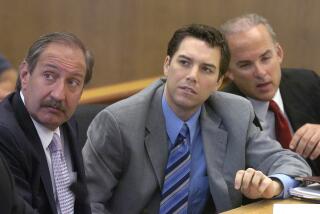Victim’s Mother Faces Stayner
- Share via
FRESNO — She had to see him, this man accused of killing her daughter. She needed to “touch the reality of this,” and confessed to worrying that she might jump up in court and howl with rage at Cary Stayner.
But when Stayner--charged with last year’s notorious Yosemite murders--shuffled into federal court Thursday, ankles and hands in chains, Leslie Armstrong felt numb.
Making her first appearance at proceedings against Stayner, the mother sat impassively as U.S. District Judge Anthony W. Ishii agreed to delay the trial from October to April 2001 at the request of a defense team struggling to get through 16,000 pages of police reports and other new trial documents.
She watched quietly as Ishii moved to send the trial to an undecided site out of state to skirt the heavy publicity the case has received in California.
She held hands with friends as Stayner shifted nervously 20 feet in front of her. And she thought of Joie Ruth Armstrong, remembering how beautiful and dynamic and driven her daughter had been.
Facing the accused “is not something you do easily,” Leslie Armstrong said later outside the federal courthouse in Fresno. But, “I needed to look at him. It’s something I have to do to get through this right now.”
Federal prosecutors are trying Stayner because Armstrong, a 26-year-old Yosemite National Park naturalist, died on federal land in July 1999. The death-penalty case will be followed by trials in state court for the slayings of three tourists near the park in February 1999.
Authorities say Stayner, a park handyman, confessed that he stalked and killed the first three victims after making up a story about a plumbing problem to get into their room. He also confessed, officials say, to beheading Armstrong several months later.
While Ishii has agreed to delay the trial in the Armstrong case to April and change the venue, yet to be decided is where the trial should be moved. Attorneys are looking for a site where courtroom space is available and a jury pool acceptable to both sides can be found. An early possibility, Seattle, is now seen as unlikely because of overcrowded court facilities.
Another lingering issue in the case is whether the public should see a prosecution document spelling out the government’s argument for the death penalty. At the request of defense attorneys who worry that it could prejudice potential jurors against Stayner, Ishii in June sealed the document, which details special circumstances of the murder.
Responding to complaints from lawyers for local newspapers, Ishii on Thursday ruled that the document will remain sealed until December, when he will consider the question again.
Other issues to be settled include the validity of Stayner’s confession. At the December hearing, the defense is expected to argue that it should be thrown out.
There also is the prospect that Stayner’s lawyers, who recently had the 39-year-old defendant undergo a brain scan, might seek to press an insanity defense as they struggle to keep their client off death row.
In the year since her daughter’s death, Leslie Armstrong has moved temporarily from her home in Orlando, Fla., to Santa Rosa, where she is caring for her ailing mother.
For months she avoided the pretrial hearings. But with a long stay in California ahead of her, Armstrong said, “I needed to face this,” so she headed off to the Fresno courthouse.
Armstrong arrived at the wood-paneled chambers Thursday with a framed photograph of her smiling daughter wearing a sundress and a hat. The mother wore Joie’s silver jewelry--rings on each finger, bracelets, chains.
She has struggled with the prospect that Stayner faces the death penalty. The Bible, she noted, teaches that we are supposed to forgive.
“Then there are my angry days,” she says, when she thinks she could carry out an execution herself.
“I don’t fester with hate, because that’s self-destructive,” Armstrong said, adding that she feels confident Stayner at the very least will spend life behind bars. “He does not deserve to sit among the human race.”
More to Read
Sign up for Essential California
The most important California stories and recommendations in your inbox every morning.
You may occasionally receive promotional content from the Los Angeles Times.













